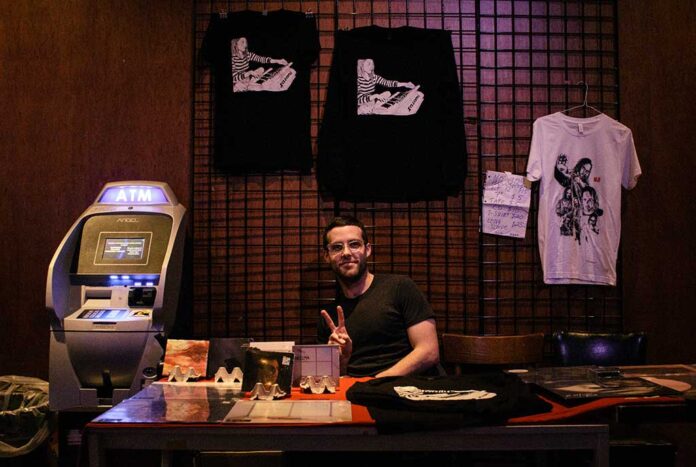
EDITORIAL BY STEPHANIE E. JENSEN
Imagine the day you see your favorite band’s show. You’re not only listening to their discography on repeat, but are counting every dollar of your spending money, hoping to snag some sick merch. When the moment comes and you arrive at the venue, you scavenge for the band’s merch table, only to not find it anywhere. You ask around, and realize the band isn’t selling merch at the show.
Unfortunately, this has been the reality for many fans, mainly due to merch cuts. More bands refuse to sell merch at shows that take a significant cut, the most recent artist being Falling in Reverse.
What was once a common practice in the business world of music is now a word thrown around on social media and news articles. But what are merch cuts? And why are they a thing in the music industry?
What Are Merch Cuts?
As the name implies, a merch cut is a percentage taken out from a band’s merchandise sales.
“When you’re [booking] a tour, there are contracts between you and all the other bands and the venues. In every American tour, it’s one of those things that’s in the [contract], like 15 or 25% [for a merch cut]. It’s different for every venue, especially if they have vendors,” explains Lochie Keough, lead vocalist of Australian metalcore band Alpha Wolf.

“Over time, promoters saw this as a possible revenue stream for them. Now you’re left with a situation where, for some reason, it’s considered the industry standard for a promoter to watch your merchandise manager set everything up, selling on your own point-of-sale equipment all night, and at the end of the night, [say], ‘You owe us 20% of what you sold,’ which is insane for me. Charging you for space at the venue, and the venues make money at the bar,” explains Northlane guitarist Josh Smith.
The practice differs with every festival and venue.
“There’s no proper regulation about it [and] there [are] no proper guidelines,” explains Keough.
Are Merch Cuts Necessary? The Case for Festivals and Arenas Versus Small and Mid-Sized Venues
Merch cuts have a purpose. For example, if the venue or festival employs its vendors, a percentage is taken out of the artist’s pay, and those funds will be used to pay the staff members.

“In the past touring, it was kind of sporadic, or once in a blue moon, we would get hit with a merch cut we would have to pay. In most circumstances, it [was] when we [were] playing a festival. Sometimes they have staff that do counts with whatever you’re bringing in, and they will sell the merch for you,” explains Devin Swank, vocalist of Sanguishugabobb.
Smith also experienced merch cuts in this setting. “When we first started to encounter merch [cuts], it was at fairly large venues that would have different merch stalls. So, you’re talking arenas or large festivals. They may have a certain place to sell merch, their own point of sales, [and] sellers. And you’re getting your merch manager to manage stock levels. [The venue staff] is taking on a significant amount of work, so that’s why they justify the percentage cut from your revenue. Back in the day, they probably thought that was the fairest way to do it.”
In some cases, bands understand when a venue or promoter must collect a merch cut.
“Vendors [are] the one reason why we don’t care about merch cuts. If you’re handling our merch and selling it throughout the night, then yes, you’re putting in the work so you deserve a cut of that,” explains Keough.
There are still some issues with festivals and venues hiring their own staff to sell a band’s merchandise. Swank also points out merch tips and how losing those funds can impact a band.
“When we go out on tour, we’ve had people who do merch for us, or we’ll do it ourselves, [and] we get tipped at the merch table. When it’s just us, we split the tips out [to] everyone in the band. When it comes to those big festivals, where they take a merch cut, and they have staff selling the merch, [the festival’s vendors] keep the tips. They earn those tips because they’re selling them, but on any other regular show, it would be us collecting the tips,” he explains.
Small and Mid-Sized Venues Taking Merch Cuts
Over time, medium-sized and even some small-sized venues discovered the practice of collecting a merch cut.
“We’ve even got hit with [merch cuts] at smaller, 300-400 [capacity] rooms,” Swank says.
When venues or promoters hire staff to sell merchandise and provide the technology to complete the sale, most argue that taking a merch cut is fair. But why would smaller venues need to collect one if artists bring merch vendors and their POS systems? While there’s no definite answer, some industry figures have their justifications for charging a merch cut, such as how bands are making a profit on their property.
Still, people have yet to learn why. Every venue or promoter has different policies.
“Having merch cuts in venues is something we see everywhere now, but it started in the US. It started to trickle down into small and medium-sized venues before that happened anywhere else,” explains Smith. “I don’t know if it’s because of certain large conglomerates buying up venues.”
However, Keough has a different answer. “They’re never at small venues. It’s the mid-tier range that say, ‘Oh, we got someone selling it.’ And it’s just like, ‘We didn’t know about that.’ You have to ask them if selling [your merch] is entirely necessary or if that’s another way to, point blank, generate more revenue,” he explains.
When Merch Cuts Become a Problem
“It’s one of those things where you do accept it technically by signing the dotted line and accepting the show. But it’s one of those problems that’s too deeply rooted and too far gone for you to be like, ‘No, I’m not doing this,’ because then the venue is just gonna lower your guarantee. It’s one of those shitty games that you have to play, but no one really plays it right, anyway,” explains Keough.
And then there’s the situation where the band doesn’t sign a contract that lists a merch cut but will arrive at the venue and find out they must pay one.
“Sometimes, they come up to you and ask you for something you’ve never heard of before or [was] detailed before,” says Keough. “One time, [we were] setting up merch, and this venue guy comes up and says, ‘All you bands, 20%.’ And then we’re like, ‘Uh, we haven’t heard about this, go talk to the tour manager.’ And he says, ‘No, I don’t talk to [the] tour manager!’ And it’s like, oh, this is [legally] sound. It gets kind of dodgy, sometimes.”
While some promoters will have specific merch cut percentages in their contract, others will up charge bands for every penny they earn.
“They charged us for the table to sell merch on,” Keough recounts one experience at a show. “They charged us to bring a table out from one of their storage closets and pull it out so we can have a table to sell our t-shirts on and sell. And then they come back at the end of the show and ask for 20% of merch sales. I don’t know what part of that is supposed to make sense other than the promoter filling his pockets up as much as he can.”
Smith has had other random fees pop up when playing a show. “There’s one particularly bad company in Australia that will charge market rates for the artist’s rider, and you’ll be paying $100 for a slab of water.”
Which Venues Are Most Likely to Charge a Merch Cut?
Merch cuts originated from festivals and major venues that hire staff to sell the merchandise. The merch cut is used to pay the staff and cover other expenses to sell the products (for example, if the venue uses its POS system).
There was a time when venues wouldn’t charge a merch cut as long as the band brought their merchandising staff and other technology or materials to sell the products. Eventually, venues and promoters started charging a merch cut, with their justifications as to why.
But is there a specific region that takes advantage of merch cuts more than others? Should bands expect to pay a merchandise cut at particular sizes or types of venues?
Keough explains that merch cuts are more common in the U.S. “It’s way more of a thing in America than Australia. Every other venue is asking for money at the end of your merch night. It really screws the budget up. It’s just not something you’re used to as an Australian band. So, when there’s this other expense on top of all your other ones, it really starts to dig things down.”
Keough continues. “In America, they try to skim you, no matter the venue [or] how shitty it is. No matter how much of the stuff they provide or that they don’t provide for you, the grimiest dive bar you play, there will be some chump at the end with his hand out like this [holds hand out]. In Australia, it’s only really the nice theaters, stadiums, [and] arenas they will ask you for [a merch cut].”
Even though the US has a big problem with merch cuts, other countries are jumping on the practice—and are handling the situation in their own ways.
“In some places, like it happens a lot in the UK, these smaller venues will unnecessarily have their own team of sellers, as well. And you’re expected to pay their wage on top of the merch cut,” Smith says.
“It’s really sort of random in Europe [and] the UK. Thinking about the last tour, I can’t remember many people coming up to us, except for random places in Europe. It’s really random, you don’t really know if it’s going to happen or not [regarding paying a merch cut],” explains Keough.
Bands may experience merch cuts infrequently in Australia, but the region presents other challenges.
“In Australia, we’ll promote our own tours. And a lot of the venues we would play at, like 3,000-cap rooms, they will vend our merch [for us] and take 20%. And there are only two venues in that city that size. If you don’t like it, you can go somewhere else,” explains Smith.
Other artists have had different experiences in the UK and European markets.
“When we did a full European tour, we weren’t hit with a merch cut at all,” Swank says. “We had a great experience, especially in the UK. They didn’t ask for a single penny.”
How Merch Cuts Affect an Artist’s Bottom Line
“We look at merch cuts kind of as robbery,” explains Swank. “Us, the artist, we’re taking money out of our pockets to fund our merch bill. The money doesn’t come from our label or management. It comes from our hard-earned money.”
Bands have numerous expenses on tour, and all these costs add up. Merchandising is one of the best ways to compensate for those expenses. Variety states that even bands playing in a mid-sized venue generate $10,000 from merch sales alone. But if a venue charges a 20% merch cut, even the $2,000 the band loses can eat into their touring expenses.
“[With] recent changes in the world—inflation, gas prices going up, food prices going up like crazy, [and oil changes] and repairs on your [vehicle] also skyrocketing—every dime you save or come back home with counts and goes a long way. Personally, I view merch cuts as a way of theft. I don’t think these venues deserve that kind of money. At the end of the day, when we go home, whatever we make from merch sales [and] our guarantee, there’s management [and] booking you have to pay. If you have anything leftover from what you’re wanting to save, you can disperse that from everyone in the band. When you take a merch cut, you’re taking money away from the band.”
To offset the costs of merch cuts and make their bottom lines, many bands have increased the prices of their merchandise.
“Quite often, the [prices] have the merch cut built into it,” explains Smith. atVenu estimates the price of a band t-shirt increased from $32 to $35 in 2022. Now, the average cost of a band t-shirt is $34.
How Merch Cuts Affect International Touring Bands
When bands fork over 20% to 25 % of their merchandise sales, it tremendously impacts their bottom line. This devastates bands touring domestically, who must invest in transportation, crew, gas, etc. But this loss is even more severe to international touring artists, who are already spending thousands on visas, legal fees, plane tickets, and their backline.
Smith offers the bleak reality of international touring expenses. “For an international artist coming to the US from Australia, flights will cost about $10,000 to $20,000 US dollars. We always have to hire a vehicle. On top of that, there are other things such as working visas, which are incredibly expensive. They’re about $30,000 for three years. A carnet, which is an import/export document, [is for] all the equipment that we fly over, and we can’t enter the US without one of those. We have to put a bond based on the value of all our equipment on that. And if we fill it out wrong, we won’t get our bonds back, which has happened to us, too. Realistically speaking, if we have to apply for a new visa, buy flights, pay a vehicle deposit, and put a carnet bonds down, you’re looking at $30,000 to $50,000 U.S. dollars in the red, before we even strike a single cord.”
It’s important also to consider the Australian dollar (AUD) versus US dollar (USD) conversion. As Smith explained, they could be spending as much as $50,000 USD before playing a single show. That figure is close to $75,000 in AUD. But what do merch cuts have to do with these expenses?
“When you’re losing 10% to 20% of your principal revenue source at the top, for [really] no proper reason (laughs), [it] makes things quite difficult. That could be $30, $40, [or] $50,000 at the end of a tour if we’re doing a month,” explains Smith.
As another Australian musician, Keough agrees. “It comes to the fact that merch is the number one big breadwinner in the band. Most of the time, you don’t get to keep all of [the merch expenses], but it’s the piece of pie that you keep the most of. So, when you already booked the flights, travel, accommodation, and everything else you need to get on a tour, you start slinging shirts. And then there’s a dude at the venue that goes, ‘Alright, now I need some of that.’”
How Others in the Music Industry Are Responding to Merch Cuts
Not all venues support taking a merch cut away from bands. Many are opposed to the practice.

“I’ve spent most of my adult life on tour, and the idea of taking a cut of something so essential to a touring musician [is something] I find morally reprehensible. It represents a complete lack of understanding of what it’s like to tour and a crystal-clear example of greedy short-term gains over sustainable mutually beneficial practices,” explains Sergio Da Silva, who handles booking at Turbo Haus in Montreal, Quebec.
Multinational entertainment company Live Nation also made headlines when they announced they will now refuse to take a merch cut from bands. Still, not all in the industry are jumping on Live Nation’s bandwagon. And Da Silva has something to say to them, “You’ve taken such [an] unpopular stance and are doing something so morally bankrupt that I find it hard to believe we can even have [a] conversation about it.”
How Bands Are Responding to Merch Cuts
Bands have been making headlines when they refuse to sell merch at shows. When bands discover massive merch cuts, not selling merchandise is their way of protesting the practice.
Architects vocalist Sam Carter shared a Tweet in February 2023, saying a venue in Melbourne took a 15% merch cut while it took them four hours to get their merch manager a light. In March 2023, avant-garde metal band Igorrr refused to sell merch at the O2 Forum in London due to a 25% merch cut. Progressive metal band Monuments boycotted two venues, not selling merch at a venue in Italy and another in Athens, Greece, due to staggering merch cut percentages. And post-metal band Russian Circles didn’t sell merch at a venue in Paris, France on March 22, 2023.
However, this protest comes with a risk. If a band can generate as much as $10,000 at a mid-sized venue, not selling merch entirely runs the risk of losing significant revenue that can be used to fund a tour. Because of that, not every band is willing to lose that potential revenue. “We would never turn down or walk away from the opportunity to sell our merch,” explains Swank.
There are instances where the band or their merchandising manager may lie to the promoter or auditor to avoid paying an enormous rate, but can’t bands negotiate merch cut rates?
“I see a lot of people commentating on social media, how we should negotiate [the rate] in the deal and not have our agent sign a contract [with a] merch rate that we’re not happy with. That’s not the way the world works. It’s either agree to these terms or you have nowhere to play,” says Smith.
That said, other artists have had luck negotiating. “We’ve gotten lucky. We can [negotiate] to give them less money than what’s promised,” explains Swank. “We’ve gotten lucky where we’re not the headlining band at that venue. We tell them, ‘Hey, we didn’t sell much, we’re trying to get off our feet, can we give you this?’ Or, ‘I haven’t been [keeping] count, I don’t know if you have. Can you take this amount of money?’” Swank says. “Usually, we try to persuade the staff, and see if they can take something less. The night ends with them getting at least something.”
Keough has had similar experiences. “Half the time, the venue just sends some random person who works [there] to collect the merch cut. So, they’re not invested. You just say, ‘I made $50,’ and they say, ‘Right, cool, give me blah blah blah percent of that.’ You can just tell that they know what they’re doing is wrong, and they feel awkward and uncomfortable with what they’re doing. So, they just accept what they’re told and run off.”
But Swank also says that in some cases, working around a venue’s merch practices can also be challenging. “If you get count in, [meaning] they count the merch you’re bringing in before [you set up] in the venue, you’re kind of screwed. [Otherwise], you could give someone certain a number, and they take a percentage of it. About nine times out of 10, if the staff is there with a clipboard [or a] laptop, ready to collect [a] record of what you’re bringing in, you’re kind of screwed.”
Then, there are times when the band runs out of the venue before anyone can stop them, but that’s rare. “The only [time] we ever walked out with avoiding the merch cut was when we were a lot younger and naive, and we just tried to load everything up and haul ass before they [could] even get to us. With how things work now, when you have TMs [tour managers], and there are bands on buses [with a] bus call, you can’t leave until some other band [does]. It’s kind of hard to do that [meaning leaving before paying the merch cut],” says Swank.
So, is there anything bands can do to avoid paying a merch cut? Some bands have also found other options. “I’ve heard of bands selling merch outside of the venue, so they can avoid a merch cut,” explains Swank. At the same time, this method isn’t the most effective. “You’re also shooting yourselves in the foot. A lot of times, there’s no re-entry, and people get hit with that a lot. They’re not going to walk outside to get your merch and come back in because you said it on stage. Usually, they look for merch next to all the other bands that are playing that same night.”
Most artists interviewed in this piece said they had to sign contracts stating the merch cut for the night. Because of this, Smith has another approach, which bands can use to their advantage.
“We always check the contracts, as well. There’s been a lot of instances where a promoter told us the merch rate for the night is 20%, and I’ve look at the contract and it [was] 12.5 or 15%. It’s something worth doing for artists, checking the agreed rate on the contract.”
Buying merch online is always an option, and some bands recommend this method. “We also push [our] online distro and store. That money goes right into our pockets,” explains Swank.
However, this isn’t always an option for fans, especially if the band is international. With shipping, duties, and taxes, these extra costs add up for fans, so many wait to buy merchandise when a band plays their town.
Should Fans Still Buy Merch at Shows?
So, the question remains: should fans still buy merchandise at shows? Most bands featured here have the same answer.
“We still tell people, ‘Buy [merch] at the show.’ We still push that because we look at it as we’re going to make the most money,” explains Swank.
“I feel like we put that up to the fan now. [By] letting fans and everybody know that venues are taking a merch cut from the bands, that’s not us telling them ‘don’t give us your money because they’re taking a merch cut.’ We still need that, too, especially on the road with random expenses, things breaking in the van, [and] equipment breaking. [We] need that cash to get by for that random unexpected stuff,” explains Keough.
There’s also something else that fans can do to offset the merch cut. “If you want to tip extra so the bands have a little more money on top of the shirt that’s going to have money taken [out], go for it,” suggests Keough.
Fans should feel comfortable buying merch and supporting bands in the way that makes the most sense to them. “We’re not expecting the fans to fix this. We’re just bringing it to your attention,” says Keough.
Will Merch Cuts Become Obsolete?
It’s difficult to answer this question. On one end, Live Nation’s announcement puts us in a positive direction. At the same time, as long as venues get staff to sell merch at festivals and major arenas, merch cuts are inevitable. The key is for more transparency, for bands to know why they must pay a merch cut and for fans to understand that part of the price they spend on a t-shirt will go toward this rate.
“I think it’s really positive that these discussions are becoming more transparent, and it’s something there’s more talk of. There [are] a lot of secrets in the music industry, now, merch rates [are] the hot topic. I think whenever these issues are addressed, change always happens. It’s something that we’re starting to see at a grassroots level. Keep pressing people about it and [share] news around if you see it on social media. These conversations should hopefully lead to long-lasting change for everyone,” says Smith.
We can also continue supporting those in the industry, such as Turbo Haus and Sergio Da Silva, who have a band-first mentality. These venues and promoters prove that some are willing to go out of their way to give back to performing artists who bring them business.
Da Silva says it best, “For acts playing 150/200 [capacity] rooms, making friends with other bands, local promoters, and fans takes up a lot of your social battery. Having to expend any of it begging for a place to stay or wondering where you’re going to eat is a waste of that energy. Us being able to provide those things allows people not [to] stress the small stuff and focus on playing a great show and developing friendships, which in turn will help the next show be better. What’s good for the band is good for the fan is good for the venue. We’re all in this together and should be trying to help each other, not nickel and dime bands over fucking merch percentages.”





















